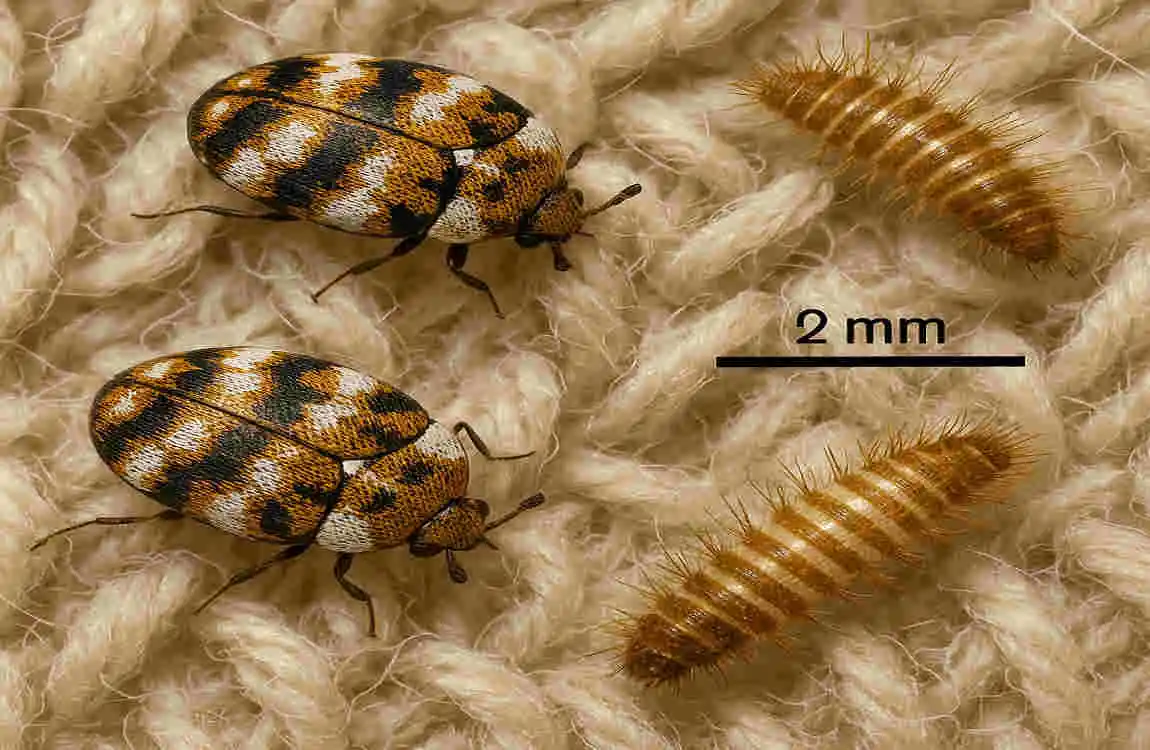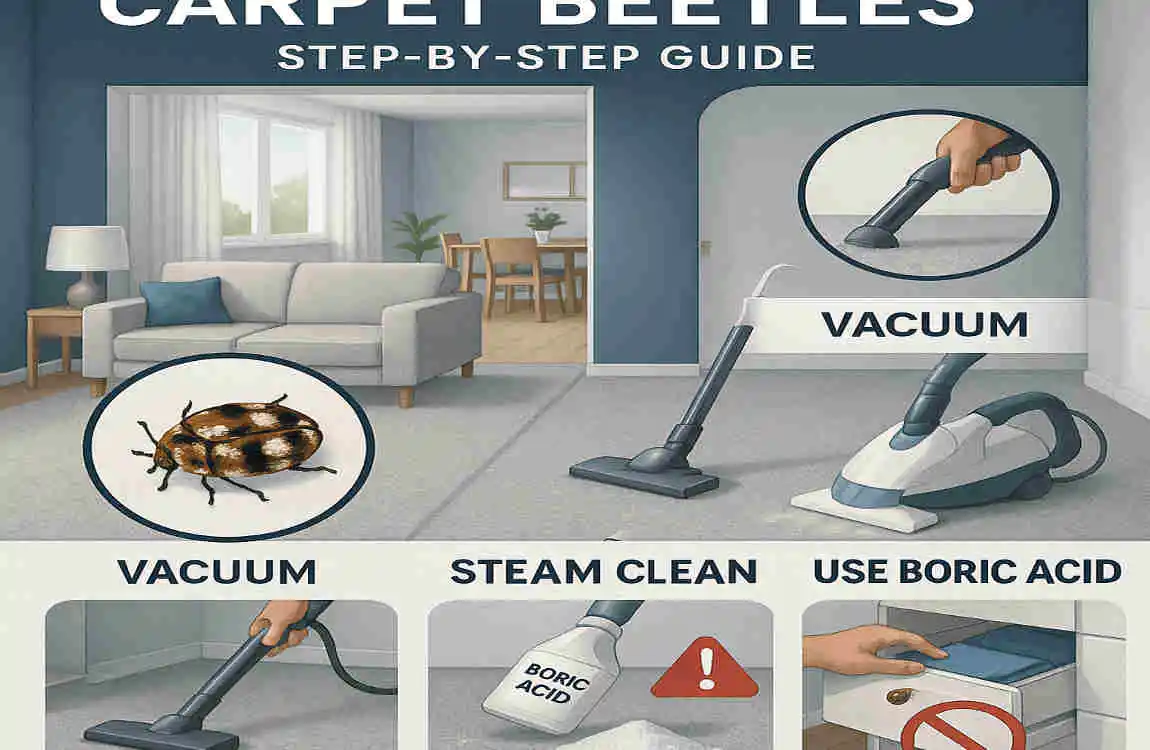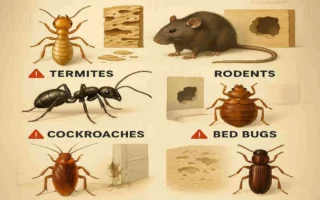Have you ever noticed tiny bugs crawling across your carpet or munching on your favourite wool sweater? If so, you might be dealing with house carpet beetles. These little pests can turn your cosy home into a battleground, damaging everything from fabrics to furniture. Don’t worry, though—I’m here to guide you through it all in a simple, step-by-step way.
House carpet beetles are small insects that love to invade homes, especially where natural fibres and organic materials hang out. They’re not just annoying; they can cause real harm. Imagine pulling out your winter clothes only to find holes chewed right through them, and or spotting larvae wriggling in your pantry, feasting on crumbs. These beetles don’t bite people, but their larvae can trigger allergies or skin irritations. That’s why spotting them early matters so much.
Why should you care? Well, an infestation of house carpet beetles can spread quickly if left unchecked. They target carpets, upholstery, clothing, and even stored food like grains or pet food. Homeowners often overlook them until the damage is done, leading to costly repairs or replacements. Think about it: replacing a ruined rug or a set of curtains isn’t cheap. Plus, if you’re sensitive to allergens, these pests can make your living space uncomfortable.
The good news? You can tackle house carpet beetles effectively with some knowledge and action. Early detection is key—catch them before they multiply. Thorough removal involves cleaning, treating, and preventing the spread of contaminants.
We’ll cover everything from natural remedies to when it’s time to call in the pros. By the end, you’ll feel empowered to protect your home. Have you checked your closets lately? If not, now’s the time. Let’s get started on banishing those house carpet beetles and keeping your space pest-free.
What Are House Carpet Beetles?

House carpet beetles might sound like something out of a horror story, but they’re actually common household pests. These tiny insects belong to the Dermestidae family, and they’re known for their love of destroying fabrics and other materials in your home. Picture a minor, oval-shaped bug, usually about 1/8 to 1/4 inch long, with colourful scales on its back. They’re not the kind that fly around your lights at night; instead, they sneak in quietly and set up shop.
There are a few common species that homeowners often encounter. The varied carpet beetle is one of the most widespread. It has a mottled pattern of white, brown, and yellow scales, making it look almost pretty—until you see the damage it causes. Then there’s the black carpet beetle, which is solid black and a bit larger. Both types infest homes across the U.S., thriving in warm, dark spots.
You may also read (how to maintain home oriental rugs for long lasting beauty).
Understanding their life cycle helps you fight back. It all starts with eggs. Adult females lay them in hidden crevices, like under furniture or in carpet edges. These eggs hatch into larvae, which are the real troublemakers. Larvae look like fuzzy caterpillars, often called “woolly bears,” with bristly hairs that can irritate your skin. They munch on anything organic for months, growing through several moults. After that, they pupate into adults, ready to mate and start the cycle over. The entire process can take anywhere from a few months to over a year, depending on the temperature and food availability.
So, how do house carpet beetles get into your home? They often hitch a ride on flowers, second-hand furniture, or even through open windows. What attracts them? Natural fibres like wool, silk, fur, and feathers are their favourites. They also go for dried animal products, such as dead insects, pet hair, or even mouse droppings. In kitchens, they might target spilt flour or crumbs. Poor ventilation and clutter make your home even more inviting.
The risks? Serious damage. Larvae chew irregular holes in carpets, leaving bare spots. They ruin clothing, turning your wardrobe into Swiss cheese. Upholstery and curtains aren’t safe either. In severe cases, they infest food stores, contaminating grains or spices. And don’t forget the health angle—those larval hairs can cause rashes or allergic reactions, especially in kids or sensitive folks.
Have you ever found mysterious holes in your socks? That could be a sign. House carpet beetles aren’t just a nuisance; they hit your wallet and comfort. By knowing what they look like and how they behave, you’re already one step ahead in protecting your home.
Signs and Symptoms of a Carpet Beetle Infestation
Spotting house carpet beetles early can save you a ton of hassle. But how do you know if they’re in your home? Let’s break it down. The most obvious signs are the bugs themselves. Adult beetles are small and rounded, often seen crawling on windowsills or walls, drawn to light. Their larvae are trickier—tiny, hairy worms that hide in dark corners.
Look for shed skins, too. As larvae grow, they moult, leaving behind empty husks that look like flaky debris. These pile up in infested areas, a clear giveaway. Another big clue? Damage to your stuff. House carpet beetles love to nibble on fabrics, creating small, irregular holes. Check your carpets for thin patches or your clothes for chewed edges. It’s like they’ve thrown a party and left confetti everywhere—except it’s your ruined belongings.
Don’t ignore your body either. Contact with larval hairs can cause skin irritation, such as itchy red bumps. Some people even experience allergic reactions, such as asthma-like symptoms, from inhaling the hairs. If you’ve got unexplained rashes, especially after handling old fabrics, it might be these pests.
Where should you search? Start in common hideouts. Closets are prime real estate for house carpet beetles, especially if you store wool or fur items there. Carpets and rugs, particularly under furniture, are hotspots—Peek into upholstery, like sofas and chairs, where crumbs and hair collect. Don’t forget vents and air ducts—these can harbour beetles and spread them around. Pet bedding is another favourite, thanks to shed fur.
Recognising these signs of house carpet beetles isn’t hard once you know what to look for. Have you noticed any of these in your home? Take a quick walk-through and inspect. Early action prevents a small problem from becoming a big one.
Common Causes and Sources of House Carpet Beetle Infestations
Wondering why house carpet beetles picked your home? It’s often not random. These pests sneak in through open doors, windows, or cracks in walls. They fly in during warmer months or hitchhike on plants, flowers, or even your shoes. Second-hand items like used furniture or thrift-store clothes are common culprits—always inspect them before bringing them inside.
What draws them in? Natural materials top the list. House carpet beetles crave wool, silk, leather, and feathers. They also love dried animal matter, such as dead bugs, rodent nests, or pet dander. In kitchens, food crumbs, spilt grains, or forgotten pantry items become beetle buffets. Clutter plays a significant role, too. Piles of laundry or dusty corners provide perfect hiding spots and breeding grounds.
Poor cleaning House habits make things worse. If you skip vacuuming or leave spills uncleaned, you’re basically rolling out the welcome mat. Humidity and warmth speed up their life cycle, so unventilated attics or basements are ideal. Seasonal factors matter—beetles are more active in spring and summer when they mate and lay eggs.
Think about your habits. Do you store seasonal clothes without washing them? That could invite trouble. By understanding these causes, you can stop house carpet beetles before they start. Let’s move on to getting rid of them.
How to Get Rid of Carpet Beetles in Your House: Step-by-Step Guide

Dealing with house carpet beetles? Don’t panic. This step-by-step guide will walk you through it. We’ll cover everything from spotting them to banishing them for good. Remember, consistency is key—follow these steps, and you’ll reclaim your home.
Identification and Inspection
First things first: confirm you have house carpet beetles. Grab a flashlight and start inspecting. Look for adults near windows or lights—they’re attracted to brightness. Check for larvae in dark, quiet spots like under beds or in closets.
Key areas include carpets, especially edges and under furniture. Examine pet bedding, upholstery, and stored fabrics. Don’t forget attics, basements, and vents. Use a magnifying glass if needed to spot tiny eggs or shed skins.
Make it thorough. Go room by room, moving furniture as you go. Note any damage or sightings. This inspection helps you understand the infestation’s scope. Have you done this yet? It’s the foundation for effective removal.
Cleaning and Removing Infested Items
Once identified, cleaning is your most effective defence against house carpet beetles. Start with vacuuming. Use a vacuum with a HEPA filter to suck up beetles, larvae, and eggs. Focus on carpets, rugs, and cracks. Empty the bag outside immediately to prevent re-infestation.
Wash infested clothes and linens in hot water—above 120°F kills larvae. Dry them on high heat, too. For non-washables like wool rugs, steam cleaning works wonders. It penetrates fibres and eliminates pests.
For heavily infested items, disposal may be the most effective solution. Seal them in plastic bags and toss them out. Freeze delicate items like feathers or furs for a week to kill beetles without damage. Clean storage areas afterwards with soapy water.
Vacuum daily at first, then weekly. This disrupts their life cycle. You’re actively fighting back—keep at it!
Treatment Options
Now, let’s talk treatments for house carpet beetles. Chemical options include insecticides labelled for indoor use. Look for ones with pyrethroids or boric acid—they target beetles safely. Spray carpets, furniture, and baseboards, following instructions carefully. Always ventilate and keep kids and pets away.
Prefer natural remedies? Essential oils like lavender, peppermint, or eucalyptus repel beetles. Mix with water and spray affected areas. Diatomaceous earth is another winner—it’s a powder that dehydrates insects. Sprinkle it on carpets, let it sit, then vacuum.
Preventive sprays and powders help too. Use carpet protectors with insect repellents. For a quick comparison, here’s a table of options:
Treatment Type Pros Cons Best For
Chemical Insecticides: Fast-acting, effective on large infestations. May contain fumes; requires safety precautions. Severe cases, quick results.
Essential Oils: Natural, pleasant smell, safe for most homes. Less potent, needs frequent reapplication: mild infestations, eco-friendly homes.
Diatomaceous Earth Non-toxic, long-lasting Messy to apply, slow-acting Preventive use, pet-friendly areas
Choose based on your needs. Combine methods for best results. Have you tried any of these?
Professional Pest Control
If DIY isn’t cutting it, call professionals. Do this for severe infestations or if beetles keep returning. Signs include widespread damage or allergies flaring up.
Pros will inspect thoroughly, often using tools like UV lights to spot hidden pests. They apply targeted treatments, such as fogging or residual sprays, which are safer than over-the-counter options.
Benefits? Expertise and guarantees. They handle chemicals properly and offer follow-ups. It saves time and ensures complete removal. Expect them to advise on prevention, too.
Costs vary, but it’s worth it for peace of mind. If house carpet beetles overwhelm you, reach out—professionals make it easy.
Preventing Future Carpet Beetle Infestations
You’ve gotten rid of house carpet beetles—great job! Now, let’s keep them out. Prevention is easier than a cure. Start with routine cleaning. Vacuum carpets and upholstery weekly, paying attention to edges and under furniture. Wipe down surfaces to remove crumbs and dust.
Store clothing properly. Use airtight containers for wool or fur items, especially off-season. Wash everything before storing to remove any eggs. Cedar blocks or lavender sachets in closets act as natural repellents.
Seal entry points. Caulk cracks around windows and doors. Install screens and weatherstripping. This blocks beetles from sneaking in.
Inspect second-hand items always. Shake out used clothes or furniture outdoors before bringing them home. A quick vacuum helps too.
Use preventive products. Insect-repellent sprays on carpets or sticky traps near windows catch early intruders.
For monitoring, check high-risk areas on a monthly basis. Set reminders—it’s simple.
Here’s a quick list of daily habits to adopt:
- Dust and declutter regularly to eliminate hiding spots.
- Clean pet areas often to remove hair and dander.
- Store food in sealed containers to avoid attracting beetles.
Stay vigilant, and house carpet beetles won’t stand a chance. Your home stays safe and comfortable.
You may also read (top benefits of professional home carpet restoration).




